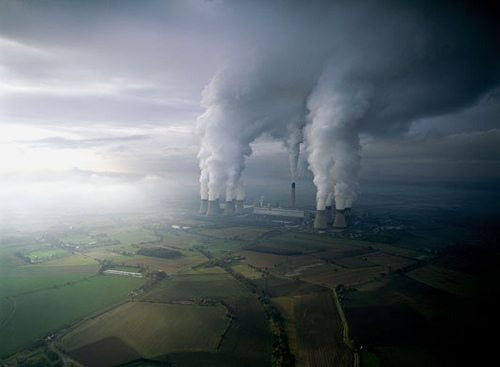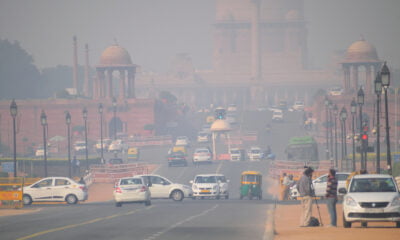

Environment
Most Polluted Streets 2015 Revealed
Friends of the Earth Scotland have released a list of the most polluted streets in Scotland which confirms that many streets are still failing to meet Scottish safety standards. The environmental campaign group analysed official Scottish Government data for two harmful pollutants, nitrogen dioxide (NO2) and coarse particles (PM10) which are known to be linked with serious health problems including heart attacks, strokes, respiratory illness and early death.
The results have been published in light of news that the Scottish government may face court action if it fails to tackle the illegal levels of air pollution in Scotland’s major cities quickly enough.
Air Pollution campaigner Emilia Hanna stated: “Streets are breaking legal limits in each major city in Scotland, demonstrating just how serious and widespread Scotland’s air pollution health crisis is. Air pollution causes over 2,000 early deaths in Scotland each year at a cost of over £1.1 billion to the economy. Air pollution increases the risk of heart attacks, strokes and asthma attacks and the main culprit is traffic.
“The Scottish Government’s Clean Air Strategy has good aspirations but needs resources and energy behind it to tackle the scourge of dirty air in our towns and cities. The government must support local authorities with funding to implement low emission zones in all major cities. It must also increase its investment in walking and cycling paths so that it becomes safer and more convenient for people to leave their cars at home. It is unacceptable that the Government is throwing £3bn at dualling the A9 while funding for walking, cycling and public transport, and measures to improve air quality remains very low. That is why we are calling on the Scottish Government to reallocate a portion of its motorways budget to active travel in the next budget.
The results for 2015:
Nitrogen Dioxide (NO2)
Top 8 most polluted streets for nitrogen dioxide in 2015.
Figures in microgrammes per cubic metre (μg/m3), European legal limit 40 (annual mean)
Edinburgh St John’s Road – 65
Glasgow Hope Street – 60
Dundee Seagate – 50
Perth Atholl Street – 48
Dundee Lochee Road – 48
Aberdeen Union Street – 46
Edinburgh Queensferry Road – 41
Aberdeen Wellington Road – 41
The Scottish air quality objective is 40 (μg/m3), so all these sites fail the objective.
The Air Quality (Scotland) Regulations 2000 required this objective to have been met by 2005.
The European Ambient Air Quality Directive sets the same legal limit for NO2 , with which the deadline for compliance was 1 January 2010. Following a legal action, the Scottish Government has been forced to come up with fresh plans to show how it will achieve compliance with European law in as short a time as possible.
Small Particles (PM10)
Top 8 most polluted streets for particulate matter in 2015
Figures in microgrammes per cubic metre (μg/m3), Scottish Air Quality Objective: 18 (annual mean)
Edinburgh Salamander St – 23
Aberdeen Wellington Road- 22
Perth Atholl Street – 20
Aberdeen Market Street – 19
Glasgow Dumbarton Road – 19
Dundee Lochee Road – 19
Falkirk West Bridge Street – 18
Rutherglen Main Street – 18
The Scottish air quality objective is 18 (μg/m3), so all these sites fail the objective.
The Air Quality (Scotland) Amendment Regulations 2002 required this objective to have been met by 2010.
Hanna continued:
“St John’s Road in Edinburgh now has the unfortunate title of being the most polluted street in Scotland with nitrogen dioxide levels well above Scottish safety standards. It was welcome news that Councillors rejected a supermarket proposal on this street in October, but Edinburgh Council needs to take much more drastic action, including looking at restricting the most polluting vehicles with a Low Emission Zone.”
“Communities are becoming much more aware of air pollution problems and are frustrated by the lack of action by authorities. 2015 saw concerted opposition to the St John’s Road supermarket proposal and groups springing up in Glasgow to demand the council does more.
“Four years after we first started publishing the list of the most polluted streets, we still find illegal levels, often in the same locations year after year. These are streets where people live, work and relax. The repeat offenders show us that local councils and the Scottish Government are not treating this public health crisis seriously enough.
“Overall there have been some improvements in the figures for 2015, which will be welcome news for those who are especially susceptible to air pollution. The exceptionally wet weather in 2015 will have reduced local air pollution levels, masking some of the underlying problem. The Scottish Government and local councils need to deliver long-term compliance with the safety standards.
“Glasgow Council is no longer measuring harmful particle pollution (PM10) in Anderston near a primary school, and on Hope Street in the city centre. Both these streets last year broke the safety standards so it is very hard to understand why the monitors have been switched off in these key known problem areas. You can’t make a pollution problem go away just by ignoring it.”
Edinburgh Resident Irene Orr, recently retired, is a long-term asthma sufferer. She relies on an extensive range of medication each day to manage her asthma.
“There is no doubt that the traffic in Edinburgh has an impact on my asthma. The very calm days are the worst as traffic fumes don’t disperse as well.
“One of the reasons I come to Corstorphine so rarely is because there is always traffic congestion on St John’s Road and it’s so polluted.
“The Council needs to crack down on people sitting in their cars with their engines idling.
“The Scottish Government needs to provide more alternatives to the car, we need cheaper public transport, and more of it.”
Corstorphine resident Scott Smith, 65 said,
“There is a huge amount of traffic on St John’s Road between Drum Brae roundabout and Clermiston Road. You can literally smell the diesel fumes on St John’s Road. The buses these days have much better emissions standards and can help solve the problem. It’s the cars and the vans which are the worst polluters.
“The traffic on this stretch has always been bad but it has got much worse because of more cars on the roads and in particular, cars with just one driver at rush hour. I don’t see the point of people driving with no passengers when there are park and rides, trams, and cheap options including buses. The Council should do much more to get the cars off the roads including restricting parking in the city centre and encouraging people to use public transport.”


 Environment10 months ago
Environment10 months agoAre Polymer Banknotes: an Eco-Friendly Trend or a Groundswell?

 Environment11 months ago
Environment11 months agoEco-Friendly Home Improvements: Top 7 Upgrades for 2025

 Features9 months ago
Features9 months agoEco-Friendly Cryptocurrencies: Sustainable Investment Choices

 Features10 months ago
Features10 months agoEco-Friendly Crypto Traders Must Find the Right Exchange





























